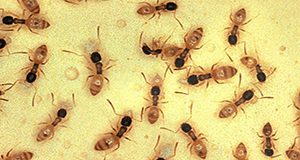Ants are one of a beekeeper’s most common pests, both in the apiary and in the honey house. Florida and the southeastern United States have a large and diverse ant fauna, with both native and exotic species. The vast majority of ant species have no impact on our bees or us. This 8-page fact sheet written by William H. Kern and published by the UF/IFAS Department of Entomology and Nematology describes the few pest species can cause serious problems and suggests ways to control the ants for healthier hives.
http://edis.ifas.ufl.edu/in1181
Tag: Ants
Florida Carpenter Ants
 Carpenter ants are in the genus Camponotus, in which up to over 900 species have been described worldwide. They get their common name, “carpenter ant,” because some species excavate nests in wood. Carpenter ants are sometimes called bulldog ants or bull ants. However, not all species in the genus Camponotus are true carpenter ants because some nest in preformed cavities or in soil. This 5-page fact sheet was original published as part of Pests in and around the Florida Home, and was written by R. J. Vazquez, P. G. Koehler, R. M. Pereira, J. Warner, and R. H. Scheffrahn, and published by the UF Department of Entomology and Nematology, October 2013.
Carpenter ants are in the genus Camponotus, in which up to over 900 species have been described worldwide. They get their common name, “carpenter ant,” because some species excavate nests in wood. Carpenter ants are sometimes called bulldog ants or bull ants. However, not all species in the genus Camponotus are true carpenter ants because some nest in preformed cavities or in soil. This 5-page fact sheet was original published as part of Pests in and around the Florida Home, and was written by R. J. Vazquez, P. G. Koehler, R. M. Pereira, J. Warner, and R. H. Scheffrahn, and published by the UF Department of Entomology and Nematology, October 2013.
http://edis.ifas.ufl.edu/in1075
Pavement ant Tetramorium caespitum (Linnaeus) (Insecta: Hymenoptera: Formicidae)
 The pavement ant is one of the most commonly encountered ants in the United States. Since first introduced from Europe at the beginning of the nineteenth century, the ant has become well established and is prevalent in urban areas in the northern U.S. and parts of Canada. However, the extent of their invasiveness and severity as a pest is not well characterized. This 5-page fact sheet was written by Tyler Vitone and Andrea Lucky, and published by the UF Department of Entomology and Nematology, September 2014.
The pavement ant is one of the most commonly encountered ants in the United States. Since first introduced from Europe at the beginning of the nineteenth century, the ant has become well established and is prevalent in urban areas in the northern U.S. and parts of Canada. However, the extent of their invasiveness and severity as a pest is not well characterized. This 5-page fact sheet was written by Tyler Vitone and Andrea Lucky, and published by the UF Department of Entomology and Nematology, September 2014.
http://edis.ifas.ufl.edu/in1047
Dark Rover Ant: Brachymyrmex patagonicus Mayr (EENY498/IN899)
 The dark rover ant is a tiny ant, native to Argentina and Paraguay, that was introduced relatively recently to the United States. It is established in the Gulf states and in some urban areas of Arizona and Nevada. It is a nuisance species because it invades and establishes nests in structures. This 6-page fact sheet was written by David Tamayo, and published by the UF Department of Entomology and Nematology, August 2011.
The dark rover ant is a tiny ant, native to Argentina and Paraguay, that was introduced relatively recently to the United States. It is established in the Gulf states and in some urban areas of Arizona and Nevada. It is a nuisance species because it invades and establishes nests in structures. This 6-page fact sheet was written by David Tamayo, and published by the UF Department of Entomology and Nematology, August 2011.
http://edis.ifas.ufl.edu/in899
Integrated Pest Management (IPM) of the Caribbean Crazy Ant, Nylanderia (=Paratrechina) pubens (Forel) (ENY2006/IN889)
 Incidents of Caribbean crazy ant infestations are on the rise! These highly active ants are
Incidents of Caribbean crazy ant infestations are on the rise! These highly active ants are
annoying to residents and pets. And, they can cause short circuits and power outages if they infest electrical equipment. Learn how to identify and apply the principles of integrated pest management (IPM) to deal with these difficult pests in this 4-page fact sheet written by Dawn Calibeo and Faith Oi and published by the UF Department of Entomology and Nematology, July 2011.
http://edis.ifas.ufl.edu/in889
